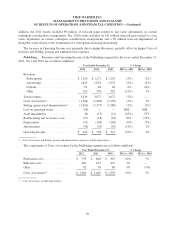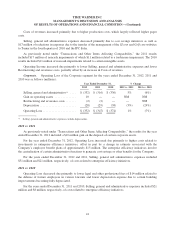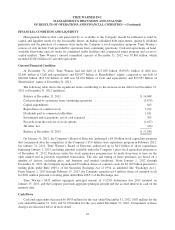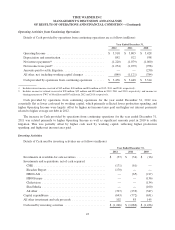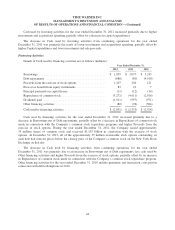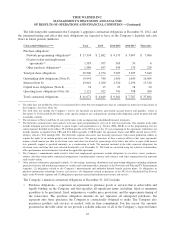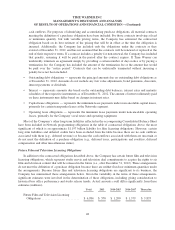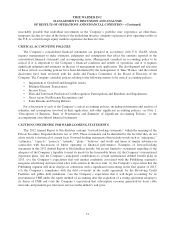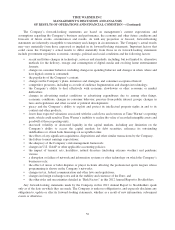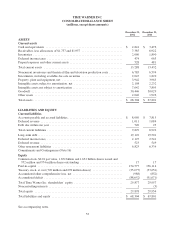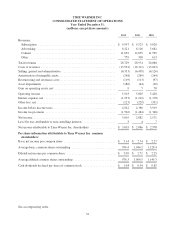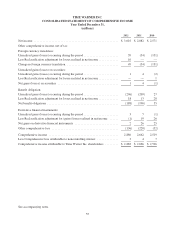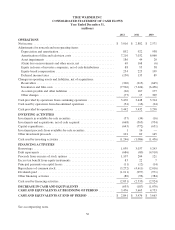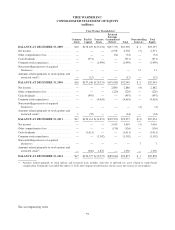Time Magazine 2012 Annual Report Download - page 64
Download and view the complete annual report
Please find page 64 of the 2012 Time Magazine annual report below. You can navigate through the pages in the report by either clicking on the pages listed below, or by using the keyword search tool below to find specific information within the annual report.
TIME WARNER INC.
MANAGEMENT’S DISCUSSION AND ANALYSIS
OF RESULTS OF OPERATIONS AND FINANCIAL CONDITION – (Continued)
cash outflows. For purposes of identifying and accumulating purchase obligations, all material contracts
meeting the definition of a purchase obligation have been included. For those contracts involving a fixed
or minimum quantity, but with variable pricing terms, the Company has estimated the contractual
obligation based on its best estimate of the pricing that will be in effect at the time the obligation is
incurred. Additionally, the Company has included only the obligations under the contracts as they
existed at December 31, 2012, and has not assumed that the contracts will be renewed or replaced at the
end of their respective terms. If a contract includes a penalty for non-renewal, the Company has included
that penalty, assuming it will be paid in the period after the contract expires. If Time Warner can
unilaterally terminate an agreement simply by providing a certain number of days notice or by paying a
termination fee, the Company has included the amount of the termination fee or the amount that would
be paid over the “notice period.” Contracts that can be unilaterally terminated without incurring a
penalty have not been included.
• Outstanding debt obligations — represents the principal amounts due on outstanding debt obligations as
of December 31, 2012. Amounts do not include any fair value adjustments, bond premiums, discounts,
interest payments or dividends.
• Interest — represents amounts due based on the outstanding debt balances, interest rates and maturity
schedules of the respective instruments as of December 31, 2012. The amount of interest ultimately paid
on these instruments may differ based on changes in interest rates.
• Capital lease obligations — represents the minimum lease payments under noncancelable capital leases,
primarily for certain transponder leases at the Networks segment.
• Operating lease obligations — represents the minimum lease payments under noncancelable operating
leases, primarily for the Company’s real estate and operating equipment.
Most of the Company’s other long-term liabilities reflected in the accompanying Consolidated Balance Sheet
have been included in Network programming obligations in the table of contractual obligations above, the most
significant of which is an approximate $1.197 billion liability for film licensing obligations. However, certain
long-term liabilities and deferred credits have been excluded from the table because there are no cash outflows
associated with them (e.g., deferred revenue) or because the cash outflows associated with them are uncertain or
do not meet the definition of a purchase obligation (e.g., deferred taxes, participations and royalties, deferred
compensation and other miscellaneous items).
Future Film and Television Licensing Obligations
In addition to the contractual obligations described above, the Company has certain future film and television
licensing obligations, which represent studio movie and television deal commitments to acquire the rights to air
film and television content that will be released in the future (i.e., after December 31, 2012). These arrangements
do not meet the definition of a purchase obligation because there are neither fixed nor minimum quantities under
the arrangements. Because future film and television licensing obligations are significant to its business, the
Company has summarized these arrangements below. Given the variability in the terms of these arrangements,
significant estimates were involved in the determination of these obligations, including giving consideration to
historical box office performance and studio release trends. Actual amounts could differ significantly from these
estimates (millions).
Total 2013 2014-2015 2016-2017 Thereafter
Future Film and Television Licensing
Obligations ......................... $ 6,984 $ 570 $ 1,200 $ 1,379 $ 3,835
48



